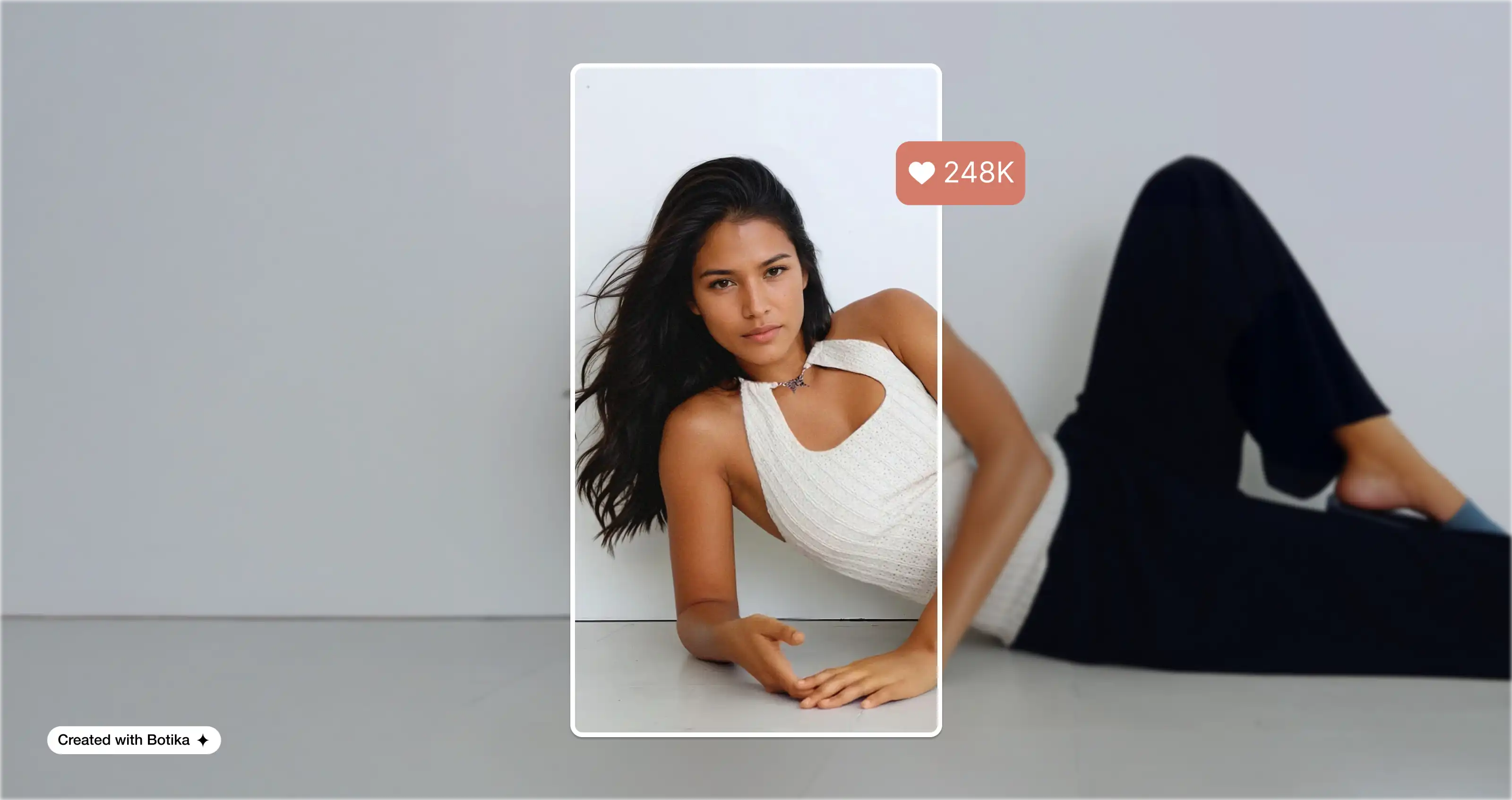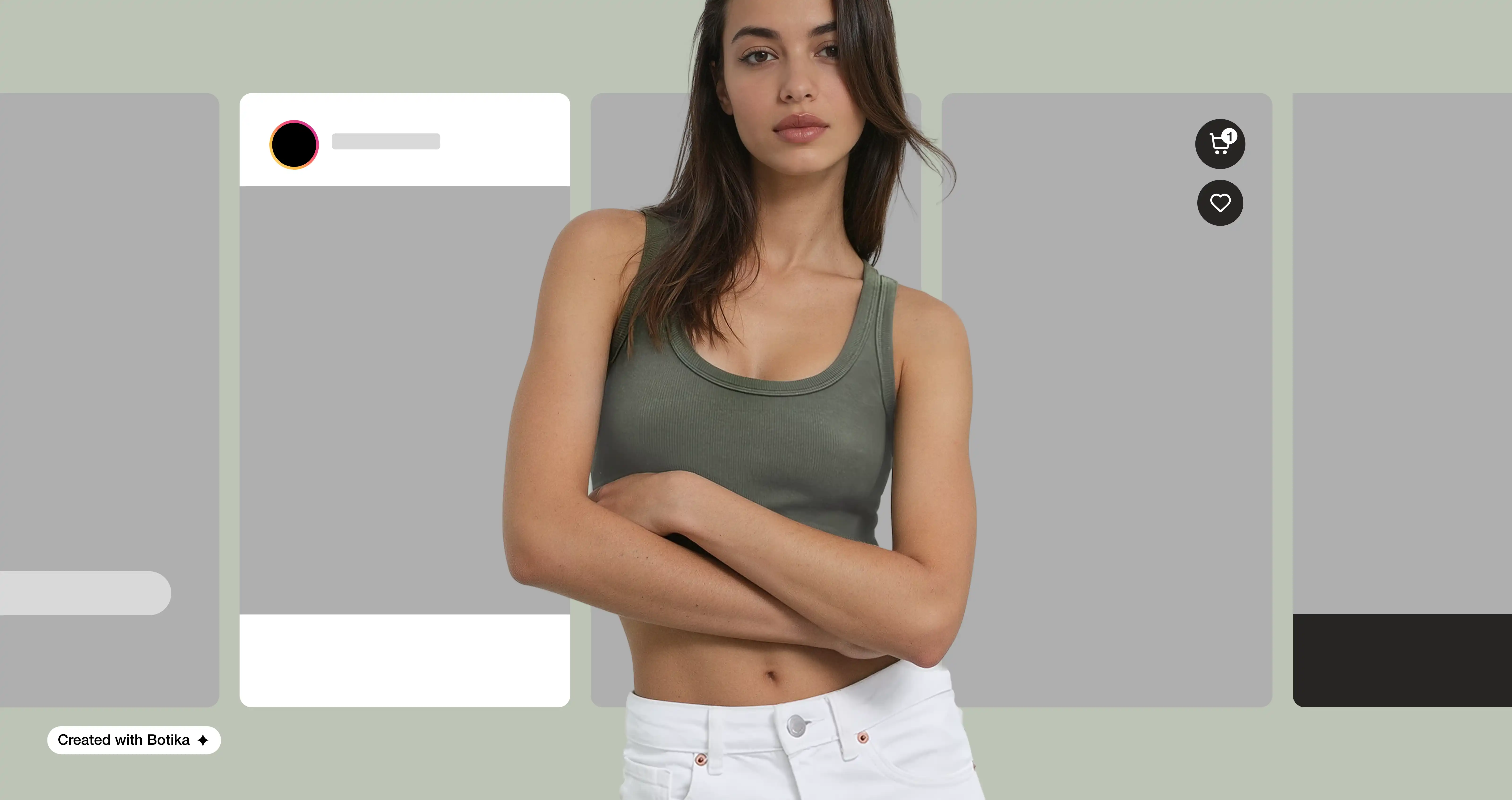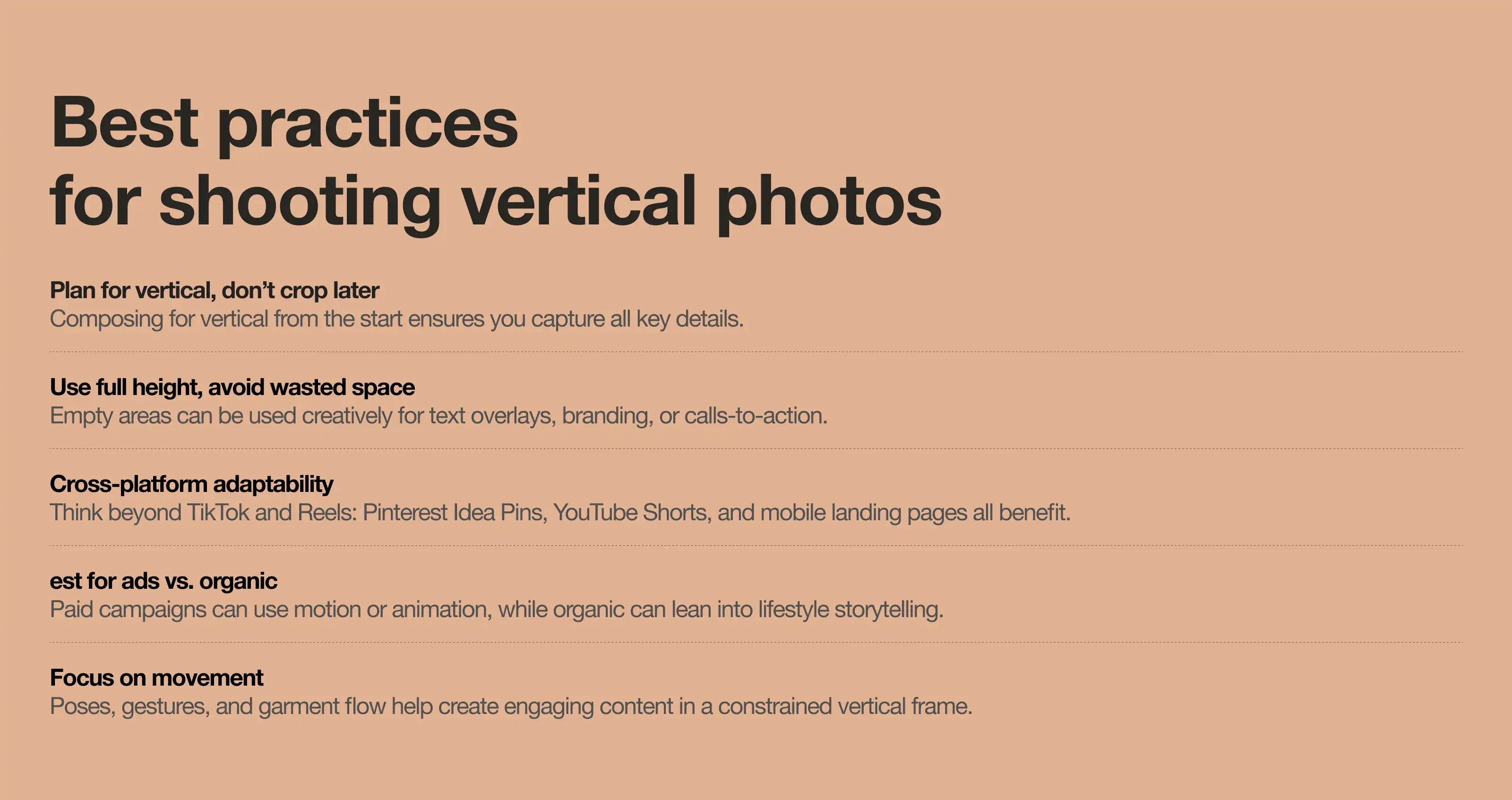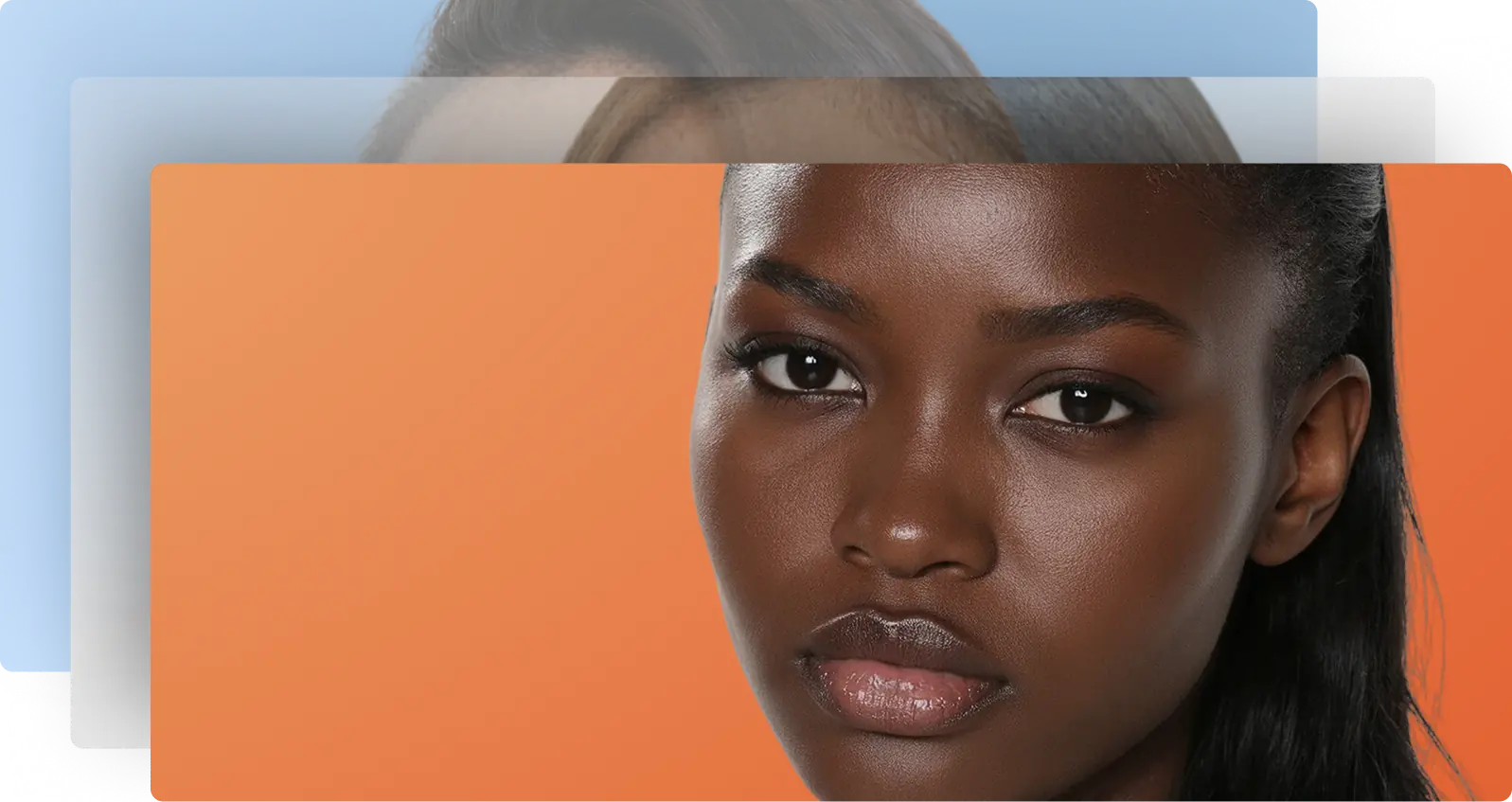The Vertical photos trend: What fashion brands should know

Mobile devices are now the primary lens through which fashion is consumed. Scrolling has replaced flipping through glossy magazines, and the majority of discovery happens vertically—on TikTok, Instagram Reels, Pinterest, and YouTube Shorts. That’s why vertical photos have become one of the most important visual trends in fashion brand photography.
This isn’t about telling brands to completely abandon traditional photography. Rather, it’s a signal that attention has shifted, and how you frame your visuals can complement existing campaigns, amplify engagement, and better meet your audience where they are. In this post, we’ll explore what vertical photos are, why they’re gaining traction, and how fashion brands can use them strategically.
The rise of vertical photos in fashion
Over the past decade, mobile-first consumption has exploded. A 2024 study found that over 75% of digital media consumption happens on mobile devices, and social feeds now favor vertical formats by default. While horizontal photography dominated print and early web layouts, vertical photos naturally fill the mobile screen and feel immersive.
Vertical-first photography is designed to maximize the screen real estate of a smartphone. It’s a way of thinking about composition from the start, rather than cropping existing horizontal images. The goal isn’t to replace traditional formats but to offer another tool for brands to capture attention in feed-driven platforms.
Why vertical photos matter for fashion brands
Fashion is storytelling, and vertical-first visuals allow that story to occupy the viewer’s full screen. Short-form video content, swipeable lookbooks, and mobile-optimized campaigns are where audiences spend the most time scrolling. Platforms like TikTok and Instagram Reels encourage users to consume content in vertical formats—making it easier to engage with dynamic campaigns without extra effort.
Brands that adopt vertical photos as a complement to their standard photography can benefit in several ways:
- Enhanced immersion
- Full-screen views reduce distractions, letting audiences focus on the garment or accessory.
- Full-screen views reduce distractions, letting audiences focus on the garment or accessory.
- Native integration
- Vertical content feels natural in social feeds, which can increase retention and completion rates.
- Vertical content feels natural in social feeds, which can increase retention and completion rates.
- Platform versatility
- Beyond social, vertical formats can be adapted for mobile eCommerce, email marketing, and even AR try-ons.
How vertical photos are changing fashion photography
Creating vertical-first content requires rethinking composition. The emphasis shifts toward height, movement, and storytelling within a narrow frame. Key adjustments include:
- Tighter crops and dynamic angles
- Instead of wide, landscape-style images, vertical shots often use elongated framing to guide the eye.
- Instead of wide, landscape-style images, vertical shots often use elongated framing to guide the eye.
- Movement over stillness
- Even in still photography, vertical-first images can use action poses or dynamic styling to feel more lively and native to mobile feeds.
- Even in still photography, vertical-first images can use action poses or dynamic styling to feel more lively and native to mobile feeds.
- Integration with UGC-style content
- Vertical visuals complement user-generated content, which often appears in the same format on TikTok and Instagram.
- Vertical visuals complement user-generated content, which often appears in the same format on TikTok and Instagram.

While horizontal photography remains ideal for lookbooks, editorial spreads, and print campaigns, vertical photos serve as a complementary tool for platforms and contexts where mobile consumption dominates.
Fashion brands winning with vertical photos
Several fashion brands are experimenting with vertical-first campaigns in ways that feel native and engaging:
- Zara and Mango
Both have leveraged vertical-first Reels to showcase micro-trends, using short, looping clips with bold movement and music.
- Skims
Vertical TikTok campaigns feature product reveals in dorm-room settings or lifestyle shots that resonate with Gen Z.
- ASOS and PrettyLittleThing
Influencer-driven vertical haul videos let micro-influencers show multiple outfits in a single swipeable experience.
The marketing payoff of vertical photos
So why invest in vertical compositions if they’re not replacing traditional formats? Because they unlock unique marketing opportunities:
- Higher engagement on mobile-first platforms
- Vertical photos consistently outperform horizontal formats in Stories, TikTok, and Pinterest.
- Vertical photos consistently outperform horizontal formats in Stories, TikTok, and Pinterest.
- Scroll-stopping authenticity
- Vertical photos mimic the native look of user-generated content, which resonates more with Gen Z and younger audiences.
- Vertical photos mimic the native look of user-generated content, which resonates more with Gen Z and younger audiences.
- Content agility
- One photoshoot can deliver multiple formats—horizontal for website banners, square for feeds, and vertical for mobile-first campaigns.
- One photoshoot can deliver multiple formats—horizontal for website banners, square for feeds, and vertical for mobile-first campaigns.
- Ad performance gains
- Brands that test vertical formats in paid media often see stronger ROI thanks to full-screen immersion.
Best practices for shooting vertical photos
If you want to experiment with vertical-first photography, here are some practical tips:
- Plan for vertical, don’t crop later
- Composing for vertical from the start ensures you capture all key details.
- Composing for vertical from the start ensures you capture all key details.
- Use full height, avoid wasted space
- Empty areas can be used creatively for text overlays, branding, or calls-to-action.
- Empty areas can be used creatively for text overlays, branding, or calls-to-action.
- Focus on movement
- Poses, gestures, and garment flow help create engaging content in a constrained vertical frame.
- Poses, gestures, and garment flow help create engaging content in a constrained vertical frame.
- Cross-platform adaptability
- Think beyond TikTok and Reels: Pinterest Idea Pins, YouTube Shorts, and mobile landing pages all benefit.
- Think beyond TikTok and Reels: Pinterest Idea Pins, YouTube Shorts, and mobile landing pages all benefit.
- Test for ads vs. organic
- Paid campaigns can use motion or animation, while organic can lean into lifestyle storytelling.
- Paid campaigns can use motion or animation, while organic can lean into lifestyle storytelling.

The balance: vertical photos as a complement, not a replacement
It’s tempting to assume vertical formats are the “new rule.” But the truth is, fashion campaigns still require multiple compositions:
- Horizontal images remain essential for websites, ads, lookbooks and editorial layouts.
- Square formats still dominate brand feeds on Instagram grids.
- Vertical photos now thrive on short-form video platforms and mobile-first placements.
Think of vertical photos as one more tool in the creative toolbox. They complement—not replace—traditional compositions, and work best when brands think in terms of content ecosystems, not single-image campaigns.
When vertical photos aren’t the best choice
Of course, vertical photos aren’t the answer to everything. Brands should avoid overusing them in contexts like:
- eCommerce product listings
- Horizontal still dominates grids.
- Horizontal still dominates grids.
- Print campaigns
- Magazines, catalogs, and billboards often require landscape.
- Magazines, catalogs, and billboards often require landscape.
- Editorial spreads
- Storytelling-heavy visuals often lean on horizontal formats.
- Storytelling-heavy visuals often lean on horizontal formats.
The key takeaway: vertical photos shine in mobile-first storytelling but shouldn’t be forced into channels where they don’t fit.
How brands can test vertical photos
If your brand is curious about adding vertical photography into the mix, here are a few ways to experiment:
- Start with Stories
- Test a vertical shot in your Instagram Stories to see if engagement outpaces square content.
- Test a vertical shot in your Instagram Stories to see if engagement outpaces square content.
- Try Paid Social A/B Tests
- Run vertical vs. horizontal ads and track click-through rates.
- Run vertical vs. horizontal ads and track click-through rates.
- Leverage Influencers
- Ask creators to deliver a mix of formats—including vertical photos—and see which perform best.
- Ask creators to deliver a mix of formats—including vertical photos—and see which perform best.
- Build a Multiformat Asset Library
- Instead of one-size-fits-all photography, create flexible assets designed for multiple placements.
<blogcta>
The future of vertical photos in fashion marketing
Vertical-first photography is here to stay, but its real strength lies in complementary use. It blends seamlessly with mobile shopping, influencer-driven content, and short-form campaigns.
- Beyond social
- Mobile eCommerce, AR try-ons, and interactive product pages benefit from vertical content.
- Mobile eCommerce, AR try-ons, and interactive product pages benefit from vertical content.
- User behavior alignment
- Meeting consumers in their natural scrolling format boosts engagement.
- Meeting consumers in their natural scrolling format boosts engagement.
- Predictive adoption
- Vertical photos will likely become an expected part of every brand’s toolkit.
- Vertical photos will likely become an expected part of every brand’s toolkit.
The future of fashion photography: Both, not either
Vertical-first and mobile-first photography isn’t about abandoning traditional campaigns—it’s about expanding your toolkit. For fashion brands, vertical photos unlock stronger engagement on mobile-native platforms while working alongside editorial spreads, eCommerce imagery, and print campaigns.
The best use cases for vertical photography include:
- Short-form social content (Reels, TikTok, Shorts, Stories)
- Mobile-first shopping experiences (optimized product views, landing pages)
- Influencer collaborations (UGC-style and lifestyle visuals for Gen Z and Millennials)
By incorporating vertical photos into your strategy, fashion brands can stay ahead of the scroll, meet audiences where they are, and create content that feels authentic, native, and compelling—without fully replacing traditional photography.
.webp)



